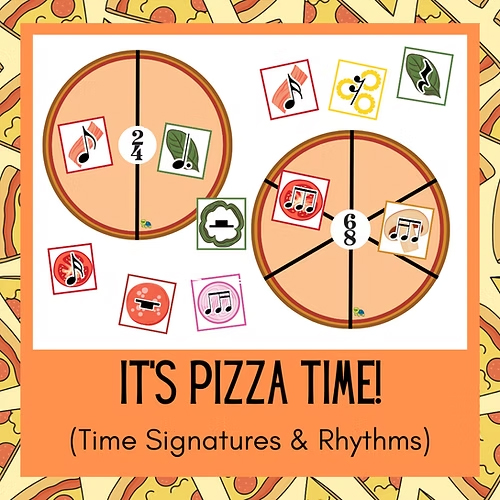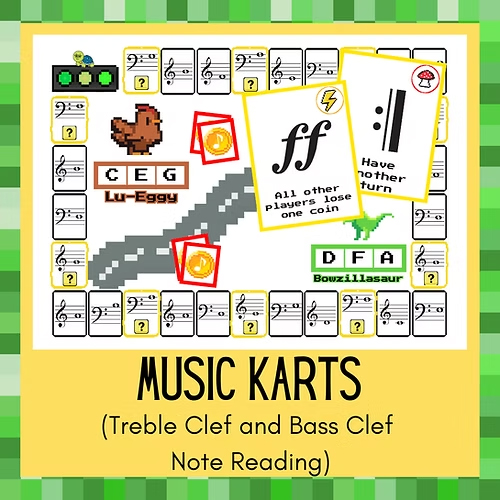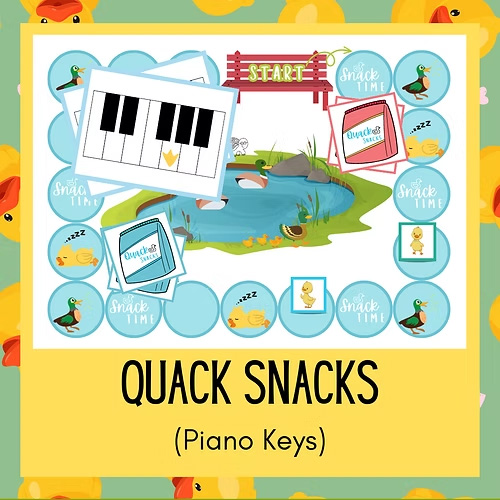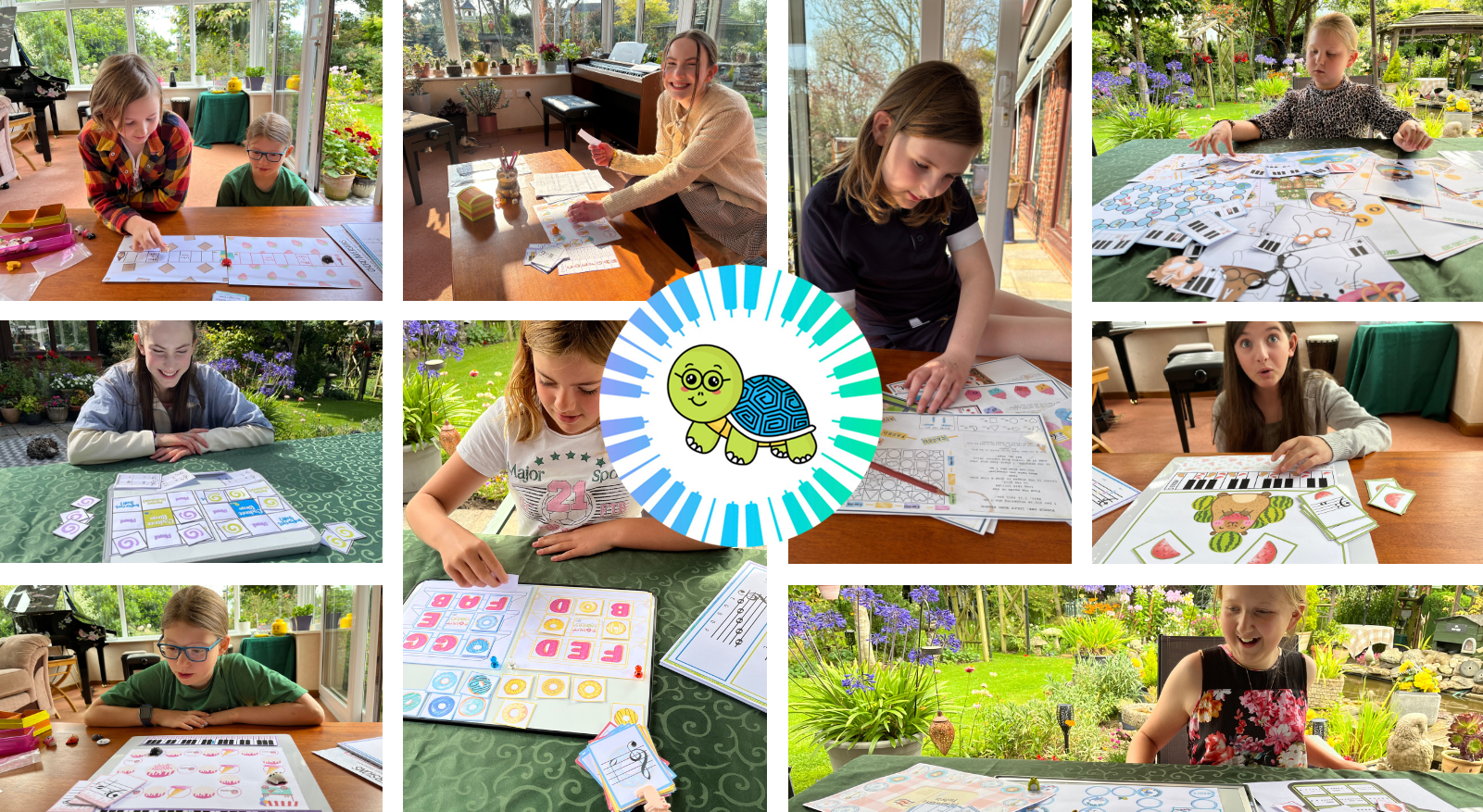Designed to make music theory fun and interactive, these popular games help kids build skills and confidence in the way they learn best - through play.
Try using pizza to teach time signatures…

…or video game characters to boost note recall…

…or ducks to reinforce the piano keys…

…and you will see that Busy Little Turtle games captivate piano students.
All you need is a color printer and some scissors!
Interview of Georgina Wilson
I started learning the piano when I was around 5 or 6, and haven’t stopped playing since then!
I started teaching in 2011 and very quickly realised that incorporating music games was the best way for me to teach theory and keep my students focused and wanting to learn.
I started selling games in 2016 (as my studio name, 'Greenside Music'). This was as a result of sharing photos of my Music Olympics online and teachers asking where they could buy the games.
Over time, I started sharing more of my ideas and games, and a few years ago, Busy Little Turtle evolved out of Greenside Music, as a place where teachers can buy music games and resources.
I plan to keep growing, adding games for different musical needs (like GCSE Music Theory) and instruments (there are a few for harp and flute already).
My family has always played board games (and we still do most Sunday afternoons!), and my partner and I love playing video games. Hardly a day goes by that I’m not thinking about games in some form!
My dad was a school teacher and was known for his out-of-the-box approach to teaching - I think I’ve inherited his desire and ability to turn anything into a fun and interesting activity to help the information sink in better!
Not one game, but games in general!
I had a student called Dan who was the most unimpressed child I’ve ever come across.
I’d test games and ideas on him, and he’d have two responses:
- When does the fun start?
- This is great, we’re doing this for the rest of the lesson.
Even after Dan stopped lessons, I kept designing games with him in mind. I always find myself thinking, “Would this pass the Dan test?”
Right now, there are 333 products in my store (what a satisfying number!) but some of those include bundles with numerous games, and there are games I’ve made that I haven’t done anything with yet. So… a number above 333!
One of my first ever games - and still a favourite among my students (and students worldwide) is Cats in Hats for the really simple reasons of
- I love cats
- It’s a super simple but fun way of testing note reading
- I love cats
- Students get really immersed and will happily read notes (especially bass clef notes) that they’d normally complain about reading
- …Did I mention I love cats?
Note reading (piano keys, treble clef, bass clef, ledger lines, solfege, landmark notes), note values, rhythm, accidentals, intervals, chords, time signatures, key signatures, dynamics, cadences, scales. Short answer: a lot!
“Not if you use them correctly!”
It’s easy to think of games as being something like, “Answer this question and then throw the ball in the hoop and see if you score.” The game then becomes more about the student’s ball-throwing ability than their musical knowledge.
But games that focus fully on reinforcement of topics are never a distraction or a waste of time.
We know that repetition is key to understanding theory concepts.
As teachers, we know that repetition is key to understanding theory concepts. But simply showing flashcards and saying, “This note is worth 2 beats, this one is 4,” can get tedious fast. Especially for kids who are so used to fast-paced games and instant gratification.
A few teachers have told me that they believe including BusyLittleTurtle music games in their lessons helps them stand out from their competition in the local area.
Several have said that students comment, “You’re more fun than the other teachers because you play games!”
I know for sure that my games are just a small reason why students prefer them, but I’m glad to be a part of what makes their studios sparkle!
(And quite a few teachers and their students refer to me as ‘Turtle Lady’!)
Interval Bam is a fast-moving game where players try and land on the correct interval spaces that match the cards in their hand.
3 Bees in a Row sees players racing to be the first to get (you’ll never guess!) three bees in a row. Identify the interval on the card, find the matching number on the board, and hope that it either helps you out or blocks your opponent!
I’m currently working on a bundle of interval games that focus on working out intervals above/below a given note, rather than identifying an interval. Keep your eyes peeled!
A game that has introduced a lot of people to BusyLittleTurtle is ‘Rain and Flowers.’ It’s a floral take on Snakes and Ladders and tests note-reading skills (either piano keys, treble clef notes, or bass clef notes).
‘Donut Worry’ is also a winner because you can use it with beginners up to intermediate, simply selecting the note cards you want to use. It’s a donut-themed bingo game that students go crazy for!
These games (and most of my note-reading games) act as 3-in-1s that grow with the student as they progress.
busylittleturtle.com is where you can find games, resources, blogs, and the Freebies Vault (accessible to email subscribers).
But I’m pretty active on https://www.instagram.com/busylittleturtle/ and https://www.facebook.com/busylittleturtle/

